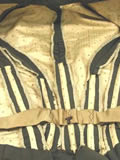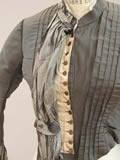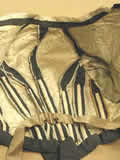Gray Silk Faille Bodice, c.1888
Introduction
The bodice which has matching center back pleats was dated in the late 1880s, by referencing Janet Arnold's Patterns of Fashion 2 and Norah Waugh's Cut of Women's Clothes. This bodice is similar to one illustrated in both books from c.1888. The bodice lacks the length of the basque bodice of the 1870s and the large sleeves of the 1890s. There is ample room in the back below the waist indicating the use of a high bustle pad or cage. Arnold corroborates Waugh's assessment about the bodice appearing in their books, dating it to c.1886, which helps place this bodice squarely in the late-1880s.
The bodice is made in the style of men’s tailoring. The bodice is unusual being that it is much larger than most extant garments so it is thought to be for a woman of larger stature. It likely not a ready-to-wear since it lacks a ready-to-wear tag or label. It is a gray silk faille main body, with silk jacquard blouson and sleeve trim. It was likely worn by an older woman because the length of the sleeve is long instead of the more common three-quarter length popular at that time.This garment was likely worn with a high bustled skirt. It sits at center back and side back and goes close to the natural waist where center front lays flat against the body and the hem dips below the natural waist.
Foundation
The fabric of the foundation is polished cotton that is flat-lined to all back pieces but separate from the front pieces. The bone casings are made of a the bias of polished cotton and machine stitched on all seams. The front panels are fitted to the body of the wearer and closed with thirteen buttons down the center front. Two darts create the bust and waist shaping. In each dart there is a bone encased in the seam allowance. The bone closest to center front measures at 7.5 inches, the second closest to the side seam measures 8 inches, and the bones from side seams to center back measure approximately 7 inches, 7 inches, 9 inches, 8 inches, and 7 inches, which can be seen in Figure 1 below. All bones drop below the waist and are made from sprung steel.
Figure 1: Interior |
 |
The bones are located within the darts on the front making it difficult to alter. There is one front pattern piece and six back panels witha double fiddle back-shape. Center back panel has pleats extending past the waist with a total of three returns. The flat-lining does not extend to these pleats. The seam finishes are bound around the edges with fabric cut on the bias, with notches cut in at waist to allow extra movement. There are small indications that the bodice was altered, located from shoulder point up on center back and on side seams as well as on the sleeve, where a small gusset can be seen. There is a waist tape with 2 hooks and eyes attached at center back and side back seams, but free from the front of the garment. This suggests that it should sit quite close to the body. Figure 2 depicts additional fabric which has been attached to bottom of armscye; this fabric was used as a stain shield and would absorb the perspiration of the wearer.
Figure 2: Underarm Protection |
 |
Front
The bodice consists of four bias strips draped from shoulder to hem connected to a faille false front. The left side of the under structure front is faille and flat lining,while the right side is only flat lining. The stitching holding down the bias strips goes through and through the foundation and can be seen on the inside of the garment. The blousson is shaped slightly to mirror the neck, waist, and hem lines. It is gathered to three stays: one each at neck, under bust, and hem. This controls the fullness of the blousson. This panel closes with hooks and eyes on the left side under the bias strips, hiding the center front closure of the under structure. It also has a small stand collar, decorated in white ribbon trim. The shoulder is dropped to the back at the shoulder point but comes to the natural shoulder at the neck point. Because of the bias strip paneling there is only one dart in the fashion fabric compared to two on foundation. Both are caught together at shoulder seam, side, and armscye. The neckline is a high closed neck that is indicative of the period. The foundation buttons are placed from hem to neck center front and are not placed on the straight grain but shaped to allow more room over the bust. The buttons, especially over the bustline, have been moved closer to the edge of center front extension to allow even more room for the wearer. The collar meets at center front but does not overlap. The buttons measure 5/8 inches across and are spaced evenly down the length of center front.
Figure 3: Front Closure and Construction |
 |
Back
The back, as seen in Figure 4 below, has six (6) panels which are flat-lined to the foundation fabric. The hemline of the back is significantly higher than the front, except for the swallowtail pleats. These pleats are cut in one piece with center back panel. The pleats are self-lined with three returns. These pleats show that emphasis was placed on the posterior, as they were designed to lie over a bustle pad located above the buttocks. There is a small alteration near center back close to the neck, possibly to allow more space over the shoulder. The returns face opposite of one another on left and right. There is a separation at the waist from center back to the side back where the bodice is not stitched together to approximately three-inches above hem. This allows for extra room over the bustle. There is also a small “V” allowing pleats to lay free. Armscyes are set farther into the back than modern garments by about 3/4" but this is fairly typical for the time. The fashion fabric is cut with the grain of the fabric running down center of each panel. The waist is set in a fairly natural location and the bodice extends approximately 3" below the natural waist, rising to about 2" at the side seam.
Figure 4: Bodice Back |
 |
Sleeves
The sleeves are smoothly set into armscye, as seen in Figure 4 above. The faille fashion fabric extends 3/4 of the way down the arm. Each sleeve has two bias bands of faille and a matching section of brocade that is "puffed." The sleeve is patterned in two pieces, upper and lower, and is moderately curved at elbow. The puff is gathered to flat lining at wrist opening where there is a small slash to allow the hand through. The sleeve edge has the same ribbon trim as the collar. Flat lining continues the entire length of sleeves. The cap is not very full which helps to date the bodice to the late 1880s and not to the 1890s, when sleeves grew to tremendously large proportions. There is a small hook and bar at the wrist which closes the sleeve. There appears to be a patterned-in gusset allowing for extra movement of the arms.
Pattern
The pattern is in 1/8 inch scale with each dot representing 1-inch. The pattern is for the historic garment and not the modern recreation which was adapted for a modern body.
© Adrienne Corral, 2013




